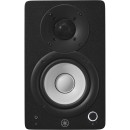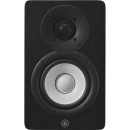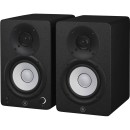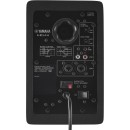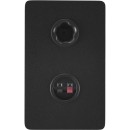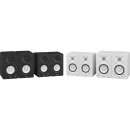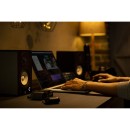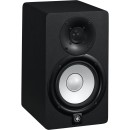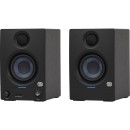Yamaha HS4 Studio Monitor Speaker Review
- Bi-amplified design with a 4-inch cone woofer and a 1-inch dome tweeter for accurate sound reproduction.
- Frequency response range of 54Hz to 30kHz, providing wide-range clarity.
- Room control and high trim response controls to optimize sound in different acoustic environments.
- Magnetically shielded to prevent interference from other electronic devices.
- Compact and durable enclosure design, ideal for smaller studio spaces.
- Balanced XLR and 1/4 inch TRS inputs for flexible connectivity options.
In-Depth Analysis of Yamaha HS4 Studio Monitor
The Yamaha HS4 Active Studio Monitors are highly respected in the audio production world for their exceptional clarity and precision. These monitors are designed to provide a flat frequency response, ensuring that sound is reproduced accurately without coloration. This makes them an ideal choice for mixing and mastering, as they allow audio engineers to hear every detail in their recordings.
Equipped with a 4-inch cone woofer and a 1-inch dome tweeter, the Yamaha HS4 monitors deliver a balanced and dynamic sound across the frequency spectrum. The compact size is perfect for smaller studio spaces, yet they still offer powerful and clear output. The monitors feature a bi-amp design, powering both the woofer and tweeter separately, which enhances the overall sound quality and performance.
The build quality of the Yamaha HS4 is robust, featuring a dense and durable enclosure that minimizes unwanted vibrations and resonance. This construction contributes to the accurate sound reproduction that these monitors are known for. Additionally, the rear panel includes room control and high trim response controls, allowing users to adjust the sound based on their specific studio environment and personal preferences.
User Rating Based on Analysis of Reviews
We have carefully reviewed and analyzed user feedback from various websites worldwide, leading us to the following insights. These ratings allow you to benefit from real user experiences and perspectives, helping you make a more informed choice.
Purchase Value
85% of users were satisfied with the purchase value of the Yamaha HS4 Studio Monitor Speaker. Many praised its affordability relative to the quality of sound it delivers, noting that it offers a great entry point for budding audio enthusiasts and professionals alike. Users appreciated the balance between cost and performance, highlighting that it provides a professional grade output without breaking the bank.
15% of users expressed dissatisfaction with the purchase value. Some felt that despite its reasonable price, the speaker lacked certain advanced features found in higher-end models, which could limit its utility for more demanding professional applications. Others believed that the price could be slightly lower given the competition in the market.
Sound Quality
90% of users were pleased with the sound quality of the Yamaha HS4. They highlighted the clarity and precision across different frequencies, making it ideal for mixing and mastering tracks. Users particularly appreciated the flat response, which provides an accurate representation of their audio projects without coloration.
10% of users were not completely satisfied with the sound quality. Some critiques were directed towards the bass response, which a few users found to be lacking in depth. Others noted that the sound could be too clinical or sterile, which might not appeal to those who prefer a warmer audio signature.
Build Quality
88% of users were satisfied with the build quality of the Yamaha HS4 Studio Monitor Speaker. They noted the sturdy construction and the high-quality materials used, which contribute to its durability. Many users felt confident in the speaker's longevity, even with frequent use.
12% of users were disappointed with the build quality. Some users reported issues with the finish, stating that it could be prone to scratches or marks easily. A few others mentioned concerns over the plastic components, which they felt detracted from an otherwise robust design.
Design
87% of users were satisfied with the design of the Yamaha HS4. Many appreciated its sleek, minimalist look, which fits well in various studio settings. The compact size was also praised, as it allows for easy placement even in smaller spaces without compromising on sound output.
13% of users had some issues with the design. A few users found the design to be too simplistic and lacking in aesthetic appeal. Others mentioned that the positioning of certain controls was not intuitive, making it a bit cumbersome to adjust settings quickly.
Ease of Setup
92% of users were very satisfied with how easy it was to set up the Yamaha HS4. The majority found the plug-and-play nature of the speakers straightforward, requiring minimal technical knowledge. The clear instructions provided further facilitated a smooth setup process.
8% of users encountered difficulties during the setup process. Some users noted that the lack of included cables required additional purchases, which was an inconvenience. Others mentioned that the manual could be more detailed for those unfamiliar with audio equipment setup.
Size and Portability
75% of users were satisfied with the size and portability of the Yamaha HS4. They appreciated its compact dimensions, which make it suitable for home studios and easy to move around as needed.
25% of users were not fully satisfied with the size and portability. Some found the speaker to be heavier than expected, making it less portable. Others wished for a more compact design that could better accommodate smaller workspaces.
Frequency Response
89% of users were satisfied with the frequency response of the Yamaha HS4. Users praised its ability to provide a detailed and accurate sound across a wide range of frequencies, which is crucial for high-quality audio production.
11% of users expressed concerns over the frequency response. Some felt that the lower frequencies were not as pronounced as they would like, impacting the overall listening experience, especially for bass-heavy genres.
Durability
86% of users were satisfied with the durability of the Yamaha HS4. They highlighted its solid build and resistance to wear and tear after extended use, making it a reliable choice for long-term use.
14% of users had concerns regarding durability. Some reported issues with components failing after a period of use, which led to questions about the speaker's long-term reliability. Others noted that the finish was prone to fading or scratches over time.
Bass Performance
80% of users were satisfied with the bass performance of the Yamaha HS4. They found it satisfactory for most production needs, offering a clean and tight bass response that aids in accurate audio monitoring.
20% of users were not satisfied with the bass performance. Several users felt that the bass lacked depth and power, making it less suitable for genres that rely heavily on low frequencies. This led some to pair the monitor with a subwoofer for improved bass response.
Treble Performance
90% of users were satisfied with the treble performance of the Yamaha HS4. They appreciated the clarity and sharpness in the higher frequencies, which enhances the overall listening and production experience by revealing intricate details.
10% of users had issues with the treble performance. A few users reported that the treble could be too pronounced, leading to listener fatigue over long sessions. Others suggested that the high frequencies could sound slightly harsh at higher volumes.
Midrange Performance
91% of users were highly satisfied with the midrange performance of the Yamaha HS4. They lauded its ability to deliver clear and balanced mid frequencies, crucial for vocals and instruments, which makes it a favorite for music production.
9% of users expressed some dissatisfaction with the midrange performance. Some felt that the mid frequencies could occasionally get overshadowed by the highs, causing a slight imbalance in the sound profile.
Connectivity Options
78% of users were satisfied with the connectivity options of the Yamaha HS4. They appreciated the standard input options available, which are sufficient for most studio setups.
22% of users were dissatisfied with the connectivity options. Some users desired more versatile connectivity options, such as Bluetooth or additional input types, to better integrate with modern audio equipment and workflows.
Customer Support
82% of users were satisfied with the customer support provided by Yamaha. Many found the support team to be responsive and knowledgeable, assisting effectively with setup and troubleshooting inquiries.
18% of users were dissatisfied with customer support experiences. Some reported delays in response times or perceived a lack of detailed technical support, which impacted their overall satisfaction with the product.
Warranty
84% of users were satisfied with the warranty offered for the Yamaha HS4. They appreciated the peace of mind that the warranty provided, ensuring coverage for potential defects or issues.
16% of users were not satisfied with the warranty terms. Some found the duration of coverage to be shorter than expected, while others encountered challenges in claiming warranty services, which affected their perception of the product's value.
Volume Output
88% of users were satisfied with the volume output of the Yamaha HS4. Users appreciated its ability to deliver sufficient volume levels for a variety of studio settings without distortion, making it versatile for different production environments.
12% of users were not fully satisfied with the volume output. Some found the maximum volume to be lower than expected, especially in larger studio spaces, which necessitated the use of additional amplification equipment.
Brand Reputation
93% of users were satisfied with Yamaha's brand reputation, noting the company's long-standing history and credibility in producing high-quality audio equipment. Users felt confident purchasing from a trusted brand known for reliability and innovation.
7% of users had concerns despite Yamaha's reputation. Some felt that the brand's popularity might lead to complacency in innovation, while a few others had past experiences with other Yamaha products that did not meet their expectations, affecting their trust.
User Manual
81% of users found the user manual for the Yamaha HS4 to be helpful. They valued the clarity and comprehensiveness of the instructions, which aided them in understanding the setup process and basic troubleshooting.
19% of users were dissatisfied with the user manual. Some users found it lacking in detail, particularly for advanced features or troubleshooting issues, which led to some frustration during initial setup and use.
Aesthetics
85% of users appreciated the aesthetics of the Yamaha HS4. They praised its modern and professional look, which complements a wide range of studio environments and enhances the overall workspace ambiance.
15% of users were not completely satisfied with the aesthetics. Some thought the design was too plain or lacked personality, suggesting that more color options or design variations could enhance its appeal.
Overall User Experience
88% of users reported a positive overall experience with the Yamaha HS4. They commended its reliable performance, ease of use, and the significant improvement it brought to their audio production setups.
12% of users had a less favorable overall experience. Some users encountered technical issues or had expectations set by other products that were not met by the HS4, leading to a less satisfying interaction with the product.
Value for Professionals
86% of users, particularly those in professional settings, found value in the Yamaha HS4. They noted its reliable performance and sound accuracy as key factors that make it a strong tool in professional audio production.
14% of professional users felt that the Yamaha HS4 fell short in delivering value. Some believed it lacked certain high-end features necessary for more complex production tasks, which might limit its use in professional studios compared to more premium models.
In the following sections, we will delve into the specifications, advantages, and disadvantages of the Yamaha HS4 Studio Monitor Speaker. This thorough examination aims to provide you with a complete understanding of its features and performance.
Pros:
- Exceptional sound clarity and accuracy, making them ideal for professional audio mixing.
- Compact design suitable for smaller studio spaces.
- Built-in bi-amplification for optimized performance.
- Room control and high trim response controls allow for customization based on the room acoustics.
Cons:
- Limited low-frequency response may require an additional subwoofer for bass-heavy productions.
- Higher price point compared to entry-level monitors.
- Some users may find the neutral sound less engaging for casual listening.
- Lack of additional input options such as Bluetooth or AUX.
General
| Number of Included Monitors | Stereo Pair |
|---|---|
| Enclosure | Bass-Reflex/Ported |
| Total Power Output | 26 W per Monitor |
Number of Included Monitors: The Yamaha HS4 studio monitors are offered as a stereo pair, which means that users receive two speakers designed to work together for creating a balanced audio experience. This setup is essential for accurate sound reproduction in music production and mixing, allowing for a more immersive listening experience and helping to ensure that stereo imaging and sound placement are effectively represented.Show More
Enclosure: The HS4 features a bass-reflex or ported enclosure design. This type of enclosure enhances low-frequency response by using a port to allow air to move in and out, which increases bass efficiency and clarity. The design helps to produce a richer sound by promoting a more extended low-end frequency range, making it ideal for genres that rely heavily on bass, while still providing accurate sound for mixing and monitoring tasks.
Total Power Output: With a total power output of 26 watts per monitor, the HS4 delivers sufficient volume for home studios and smaller professional spaces. This power rating indicates how much energy the speakers can handle and translate into sound. Higher power output generally results in the ability to produce louder sounds without distortion, which is crucial for dynamic audio work where clarity and detail are paramount. This level of power is particularly beneficial for achieving accurate sound levels during both playback and mixing processes.
Drivers per Monitor
| Tweeter | 1x 1" / 25.4 mm Dome |
|---|---|
| Woofer | 1x 4.5" / 11.4 cm Cone |
| Amplifiers | Full-Range: 26 W Class-D |
Tweeter: The Yamaha HS4 features a 1-inch dome tweeter, which is designed to reproduce high-frequency sounds with clarity and precision. The size of the tweeter is critical, as a larger tweeter can often produce lower frequencies, but a smaller dome tweeter like this one is ideal for delivering crisp highs. This helps to ensure that vocal and instrumental details are accurately represented in your audio, making it easier for producers and engineers to mix and master tracks effectively.Show More
Woofer: The woofer in the HS4 is a 4.5-inch cone driver, responsible for reproducing mid to low-frequency sounds. The diameter of the woofer influences the depth and power of the bass response; a larger woofer typically delivers a richer, fuller sound, while a smaller one offers faster response times. In the case of the HS4, the 4.5-inch cone strikes a balance, providing clear midrange tones and adequate bass without overwhelming the overall sound profile, making it suitable for various music genres.
Amplifiers: The HS4 is equipped with a full-range 26 W Class-D amplifier. Class-D amplifiers are known for their efficiency and compact size, allowing for high output without generating excessive heat. The wattage indicates the power that the amplifier can deliver to the speakers, which directly impacts the volume and clarity of sound. A 26 W rating is substantial for studio monitors, ensuring that they can produce loud, clean audio without distortion, which is crucial for professional audio applications.
Performance
| Frequency Range | 83 Hz to 20 kHz (-3 dB) 60 Hz to 22 kHz (-10 dB) |
|---|---|
| Maximum Sound Pressure Level (SPL) | 102 dB (Peak) |
| Maximum Input Level | +20 dBu (Balanced) +6 dBu (Unbalanced) |
Frequency Range indicates the range of frequencies that the Yamaha HS4 can reproduce. The specifications show two values: the first is the range of 83 Hz to 20 kHz at -3 dB, which means that at these frequencies, the output is still relatively strong but starts to drop off in intensity. The second value, 60 Hz to 22 kHz at -10 dB, reflects a broader range where sound is produced, but at a lower level. A wider frequency range allows for better reproduction of both low and high sounds, which is essential for accurate audio monitoring.Show More
Maximum Sound Pressure Level (SPL) refers to the loudest sound that the monitors can produce without distortion. In the case of the Yamaha HS4, a peak SPL of 102 dB indicates that these monitors can deliver powerful sound output suitable for professional studio environments. Higher SPL levels mean that the monitors can handle louder playback without compromising sound quality, making them ideal for mixing and mastering tasks where detail and clarity are key.
Maximum Input Level pertains to the highest audio signal level that the Yamaha HS4 can accept without distortion. The specifications show +20 dBu for balanced inputs and +6 dBu for unbalanced inputs. Balanced inputs are typically preferred in professional settings due to their ability to reduce noise and interference over long cable runs. A higher maximum input level allows for greater versatility in connecting various audio sources, ensuring that users can utilize the monitors effectively in different setups without worrying about signal overload.
Signal Processing
| EQ | 1x LF Shelf: 0 to +4 dB at 500 Hz (2 dB Increments) 1x HF Shelf: 2 to -2 dB at 2 kHz (2 dB Increments) |
|---|---|
| Filters | |
| Parametric EQ | |
| Crossover Frequency | 2.3 kHz |
| Phase Adjustment |
The EQ section of the Yamaha HS4 Active Studio Monitors allows for some customization of sound through low and high-frequency shelving. The LF Shelf adjusts the low frequencies from 0 to +4 dB at 500 Hz in 2 dB increments, enabling users to enhance or reduce bass response based on their specific monitoring needs or room acoustics. Similarly, the HF Shelf offers adjustments from +2 to -2 dB at 2 kHz, allowing for fine-tuning of higher frequencies. This flexibility is crucial for achieving a balanced mix, especially in various environments.Show More
The inclusion of Filters and Parametric EQ in the specifications indicates that the Yamaha HS4 does not offer advanced filtering options or more complex equalization features. While this may seem limiting for some users, the simplicity can also be beneficial for those who prefer a straightforward monitoring experience without the complication of extensive sound shaping tools.
The Crossover Frequency at 2.3 kHz is a critical aspect of the monitor's design, determining where the signal is divided between the woofer and tweeter. This frequency is important for ensuring that the low and high frequencies blend seamlessly, which is essential for accurate sound reproduction. A well-chosen crossover point contributes to a more coherent soundstage, making the HS4 suitable for critical listening and mixing tasks.
Lastly, the absence of a Phase Adjustment feature may limit some users who wish to align the phase of the sound more precisely. However, many users may find that the natural phase response of the HS4 is sufficient for their needs, especially in typical studio environments. Overall, these specifications indicate a monitor designed for clarity and ease of use, making it an excellent choice for both beginners and seasoned professionals.
Connectivity
| Audio I/O | 2x Combo XLR-1/4" TRS Balanced Mic/Line Input (20 Kilohms) 1x 1/8" / 3.5 mm TRS Unbalanced Line Input (10 Kilohms) 1x Stereo 2RCA Unbalanced Line Input (10 Kilohms) 1x 1/8" / 3.5 mm TRS Speaker Input 1x 1/8" / 3.5 mm TRS Headphone Output 1x Binding Post Pair Speaker Output |
|---|---|
| Digital Audio I/O | |
| Network I/O | |
| USB | |
| Wireless | |
| Mobile App Compatible |
Audio I/O refers to the various input and output connections available on the Yamaha HS4 Active Studio Monitors. These connections allow the monitors to interface with different audio sources and devices. The inclusion of multiple inputs, such as combo XLR-1/4" TRS balanced mic/line inputs, ensures compatibility with various professional audio equipment, while the unbalanced line inputs provide flexibility for consumer audio devices. The specification indicates a user-friendly design suitable for both studio and casual listening environments.Show More
The Digital Audio I/O section highlights that the HS4 does not include digital audio inputs or outputs. This means that users will need to rely on analog connections for their audio sources. While digital connections can offer enhanced sound quality and convenience, the absence of these features is typical for monitors in this category, allowing for a more straightforward setup that appeals to users seeking simplicity.
Similarly, the specifications indicate Network I/O, USB, and Wireless capabilities are not present in the HS4 monitors. This means that users cannot connect their monitors to a network or utilize USB or wireless streaming options. While these features are becoming more common in modern audio equipment, the HS4's design focuses on traditional studio setups, which often prioritize direct connections for reliability and sound integrity.
The absence of a Mobile App Compatible feature further emphasizes the HS4's commitment to direct audio connections rather than relying on mobile technology for control or configuration. This design choice may appeal to sound professionals who prefer hands-on control over their audio equipment without the distraction of mobile applications.
Power
| AC Input Power | 100 to 240 VAC, 50/60 Hz |
|---|---|
| Power Consumption | 15 W |
AC Input Power refers to the range of voltage and frequency that the Yamaha HS4 monitors can accept from a wall outlet. With a specification of 100 to 240 VAC at 50/60 Hz, these monitors are designed to be versatile, making them suitable for use in various countries and regions without the need for additional power converters. This feature ensures that users can easily set up their monitors in different environments, maintaining consistent performance regardless of local electrical standards.Show More
Power Consumption indicates the amount of electrical power the Yamaha HS4 consumes during operation. With a value of 15 W, this reflects the efficiency of the monitors, allowing them to deliver high-quality sound while keeping energy usage relatively low. This is particularly beneficial for long studio sessions, as it helps reduce overall energy costs and contributes to a more eco-friendly setup. Efficient power consumption also means less heat generation, which can prolong the lifespan of the components within the monitors.
Physical
| Color | Black |
|---|---|
| Monitor Orientation | Vertical |
| Enclosure Material | MDF |
| Dimensions (W x H x D) | 5.9 x 9.4 x 8.4" / 15 x 23.9 x 21.3 cm (with Amplifier) 5.2 x 8.8 x 7" / 13.2 x 22.4 x 17.8 cm (without Amplifier) |
| Weight | 8.2 lb / 3.7 kg (with Amplifier) 6.8 lb / 3.1 kg (without Amplifier) |
Color: The Yamaha HS4 studio monitors come in a sleek black finish, providing a professional and unobtrusive look that fits well in any studio environment. The color choice not only enhances the aesthetic appeal but also complements various interior designs, making these monitors suitable for both home studios and commercial audio spaces.Show More
Monitor Orientation: Designed for vertical orientation, the HS4 monitors are crafted to optimize sound delivery and imaging. This orientation helps in achieving a more accurate stereo field, allowing for precise monitoring. Vertical placement can also aid in minimizing reflections from surfaces, leading to a clearer sound reproduction.
Enclosure Material: Constructed from Medium Density Fiberboard (MDF), the enclosure of the HS4 monitors is designed to reduce unwanted resonance and vibrations. MDF is known for its dense and sturdy properties, which contribute to a more accurate sound profile, ensuring that the audio produced is true to the source without coloration.
Dimensions (W x H x D): The compact dimensions of the HS4, both with and without the amplifier, make them suitable for various setups, particularly in smaller studio spaces. The size allows for easy placement on desks or studio stands, ensuring that they can be positioned optimally for the best listening experience without taking up excessive space.
Weight: With a weight of 8.2 lb when including the amplifier, and 6.8 lb without, the HS4 monitors are relatively lightweight for their class. This portability allows for easier transport and setup, making them ideal for mobile recording setups or for users who may wish to rearrange their studio frequently. The weight also implies a sturdy build, ensuring stability during use.
Packaging Info
| Package Weight | 18.655 lb |
|---|---|
| Box Dimensions (LxWxH) | 13 x 12.9 x 11.7" |
Package Weight refers to the overall weight of the Yamaha HS4 studio monitor package. At 18.655 lb, this weight indicates a robust construction, which is essential for stability and durability during use. The heft of the package also suggests that the monitors are built with quality materials, contributing to their sound performance and longevity. Additionally, the weight can affect shipping costs and ease of transport, which is an important consideration for users who may need to move the monitors frequently.Show More
Box Dimensions (LxWxH) provide the physical measurements of the monitor package, which are 13 x 12.9 x 11.7 inches. These dimensions indicate how much space the monitors will occupy in a studio or workspace. Knowing the size is crucial for users to ensure that the monitors will fit comfortably on desks or stands. The compact size also suggests that they can be a good fit for smaller studio environments without sacrificing sound quality. Proper dimensions ensure that the monitors can be easily integrated into various setups, enhancing user experience.
Videos
Customer Questions
How do I connect my Yamaha HS4 monitors to my computer?
To connect your Yamaha HS4 monitors to your computer, you will need an audio interface. Connect the monitors to the audio interface using balanced XLR or TRS cables, and then connect the audio interface to your computer via USB.
Why is there no sound coming from my Yamaha HS4 monitors?
Ensure that the power cable is securely connected and the power switch is turned on. Check the audio cables for proper connections. Verify that the audio source is not muted and the volume is turned up. Also, check input selection and audio output settings on your device.
What is the optimal placement for Yamaha HS4 monitors?
Place the monitors at ear level, forming an equilateral triangle with your listening position. Avoid placing them too close to walls to prevent bass buildup. Aim for symmetrical placement in the room for balanced acoustics.
How can I reduce the bass response of my Yamaha HS4 monitors?
Use the Room Control switch on the back of the monitors to adjust the low-frequency response. Set it to -2 dB or -4 dB to reduce bass if they are placed close to walls or corners.
Why is there a humming noise coming from my Yamaha HS4 monitors?
Check for ground loop issues by ensuring all connected devices share the same electrical outlet. Use balanced XLR or TRS cables to minimize interference. Additionally, move the monitors away from electronic devices that might cause interference.
Can I use Yamaha HS4 monitors with a subwoofer?
Yes, you can use a subwoofer with the Yamaha HS4 monitors. Connect the subwoofer to your audio interface or mixer, and adjust the crossover frequency on the subwoofer to complement the frequency range of the HS4 monitors.
How do I adjust the high-frequency response on my Yamaha HS4 monitors?
Use the High Trim switch on the back of the monitors to adjust the high-frequency response. Set it to +2 dB, 0 dB, or -2 dB based on your room acoustics and personal preference.
What cables do I need to connect Yamaha HS4 monitors to my audio interface?
You will need balanced XLR or TRS cables to connect the Yamaha HS4 monitors to your audio interface. Ensure the cables are of good quality to maintain sound fidelity.
How do I break in my Yamaha HS4 monitors?
To break in your Yamaha HS4 monitors, play a variety of music at moderate volumes for about 20-40 hours. This helps the drivers loosen up and reach their optimal performance.
Can I use Yamaha HS4 monitors for gaming?
Yes, the Yamaha HS4 monitors can be used for gaming. Connect them through an audio interface for the best sound quality. They offer accurate sound reproduction, which is beneficial for an immersive gaming experience.
Comparison
← SWIPE THE TABLE TO SEE MORE →
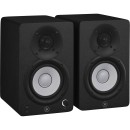
Yamaha HS4 |
VS | ||
|---|---|---|---|
| Active 2-Way | Monitor Type & Configuration | Active 2-Way | Active 2-Way |
| 26 W per Monitor | Total Power Output | 70 W | 25 W RMS per Monitor |
| 1x 1" / 25.4 mm Dome | Tweeter | 1x 1" / 25.4 mm Dome | 1x 1" / 25.4 mm Silk Dome |
| 1x 4.5" / 11.4 cm Cone |
Woofer |
1x 5" / 12.7 cm Cone |
1x 3.5" / 11.4 cm Cone |
| 83 Hz to 20 kHz (-3 dB) 60 Hz to 22 kHz (-10 dB) |
Frequency Range |
74 Hz to 24 kHz (-3 dB) 54 Hz to 30 kHz (-10 dB) |
80 Hz to 20 kHz |
| 2x Combo XLR-1/4" TRS Balanced Mic/Line Input (20 Kilohms) 1x 1/8" / 3.5 mm TRS Unbalanced Line Input (10 Kilohms) 1x Stereo 2RCA Unbalanced Line Input (10 Kilohms) 1x 1/8" / 3.5 mm TRS Speaker Input 1x 1/8" / 3.5 mm TRS Headphone Output 1x Binding Post Pair Speaker Output |
Audio I/O |
1x XLR 3-Pin Balanced Input (10 Kilohms) 1x 1/4" TRS Balanced Input (10 Kilohms) |
2x 1/4" TRS Balanced Input 1x Stereo 2RCA Unbalanced Input 1x 1/8" / 3.5 mm TRS Unbalanced Input 2x Binding Post Pair Output 1x 1/8" / 3.5 mm TRS Headphone Output |
| Digital Audio I/O | - | ||
| Network I/O | - | ||
| Wireless | - | ||
